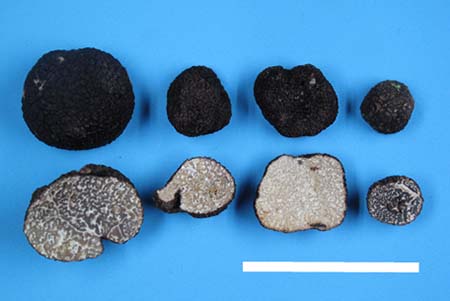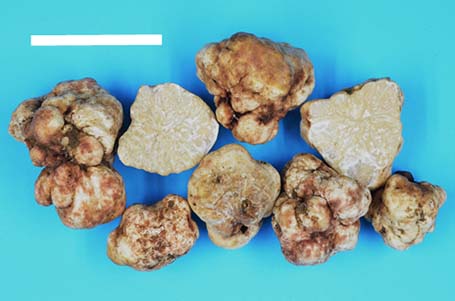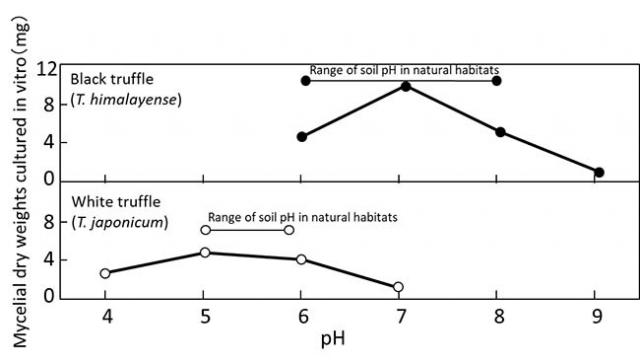Home > Research > Research Results > Research Results 2020 > Growth condition differences between two Japanese truffle species
Update:July 15, 2020
Main content starts here.
Growth condition differences between two Japanese truffle species
| Article title |
(1) Soil properties in Tuber himalayense and Tuber japonicum habitats in Japan (2) Influence of pH on in vitro mycelial growth in three Japanese truffle species: Tuber japonicum, T. himalayense, and T. longispinosum |
|---|---|
| Author (affiliation) |
(1) Hitomi Furusawa (a), Takashi Yamanaka (b), Akihiko Kinoshita (c), Shota Nakano (d), Kyotaro Noguchi (e), Keisuke Obase (d) (a) Department of Forest Soil, FFPRI, Tsukuba, Ibaraki, Japan. (b) Principal Research Director, FFPRI, Tsukuba, Ibaraki, Japan. (c) Kyushu Research Center, FFPRI, Kumamoto, Japan. (d) Department of Mushroom Science and Forest Microbiology, FFPRI, Tsukuba, Ibaraki, Japan. (e) Tohoku Research Center, FFPRI, Morioka, Iwate, Japan. (2) Shota Nakano (a), Akihiko Kinoshita (b), Keisuke Obase (a), Noritake Nakamura (a), Hitomi Furusawa (c), Kyotaro Noguchi (d), Takashi Yamanaka (e) (a) Department of Mushroom Science and Forest Microbiology, FFPRI, Tsukuba, Ibaraki, Japan. (b) Kyusyu Research Center, FFPRI, Kumamoto, Japan. (c) Department of Forest Soil, FFPRI, Tsukuba, Ibaraki, Japan. (d) Tohoku Research Center, FFPRI, morioka, Iwate, Japan. (e) Principle Research Director, FFPRI, Tsukuba, Ibaraki, Japan. |
| Publication Journal |
(1) Bulletin of the Forestry and Forest Products Research Institute 19(1): 55-67, March 2020, FFPRI URL:https://www.ffpri.affrc.go.jp/pubs/bulletin/453/453toc-en.html (2) Mycoscience, Volume61(2):58-61, March 2020 DOI:10.1016/J.myc.2019.12.001( External link ) |
| Content introduction |
Truffles, which have a unique flavor, are held in high esteem in Western cuisine. In recent years, some truffles that are promising edible have been found in Japan. In this study, we investigated the artificial cultivation of two of these truffle species, the black truffle (Tuber himalayense) and the white truffle (Tuber japonicum), by investigating the soil properties at growth sites for each of these truffle species in Japan. At the T. himalayense sites, soil pH ranged from 6 to 8, and available soil nutrients, such as exchangeable cations, were abundant. Soil at the T. japonicum sites had a pH of 5–6 (weakly acidic), and less soil nutrients were available compared to that at the T. himalayense sites. We then investigated the effect of pH of the medium on truffle growth. T. japonicum grew well at pH 5.0 and 6.0, whereas T. himalayense grew well at pH 7.0. These results show that the ideal growth conditions for these two species differ, as these species have adapted to their unique soil environments. We plan to continue researching techniques for the artificial cultivation of these two species using these results.
Photo: Black truffle (T. himalayense) on the left; White truffle (T. japonicum) on the right. Scale bar shows 5 cm.
Figure:Soil pH in the natural habitats of the two Japanese truffle species, and the mycelial dry weights cultured under different pH conditions in vitro. |
Copyright © Forest Research and Management Organization. All rights reserved.



